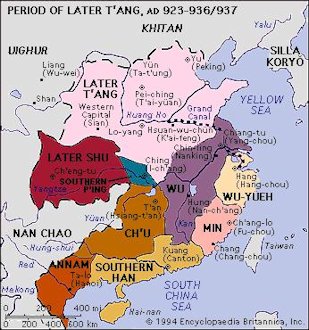
|
Five Dynasties and Ten Kingdoms
Later Tang Dynasty - 923 to 936 - 13 Years Formation of the Later Tang Dynasty From the fall of the Tang Dynasty in 907, a rivalry had developed between the successor Later Liang Dynasty, formed by Zhu Wen and the State of Jin by Li Keyong in present-day Shanxi. That rivalry was not quelled by the death of Li Keyong. His son, Li Cunxu continued to expand Jin territories at the expense of the Later Liang. The fact that an alliance forged by Li Keyong with the powerful Khitan, who, like the Shatuo Turks, were also a people of the northern steppe, was maintained, figured significantly in the expansion and ultimate triumph of the Shatuo Turks. Li Cunxu was successful in overthrowing the Later Liang Dynasty in 923 and proclaimed himself emperor of the Later Tang Dynasty, which he referred to as the "Restored Tang." As a part of "restoring the Tang," the capital was moved back to the old Tang eastern capital of Luoyang. Extent of Control The Later Tang controlled considerably more territory at its height than did the Later Liang Dynasty. Not only did it control all northern Chinese territories controlled by the previous dynasty, it held onto control of its own base in Shanxi. It also had control over the areas around Beijing and Shaanxi, which were not entirely under the control of the Later Liang. The largest expansion of the Later Tang occurred in 925 when they conquered the Former Shu State, centered in present-day Sichuan. However, as Later Tang power was waning, a Later Shu state formed in 934, one year prior to the fall of the Later Tang. Return to Five Dynasties Page On to Later Jin Dynasty ⇨ |